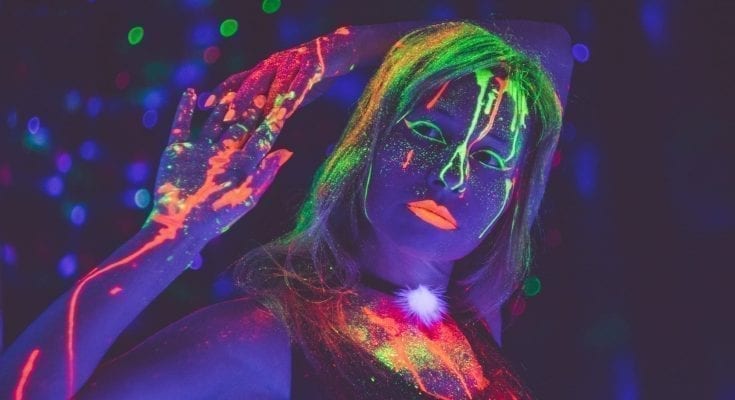Back in 2017, the dance group Light Balance made waves when they got the coveted “golden buzzer” on the television show America’s Got Talent. What made their group stand out from the dozens of other dance crews on the show? They dance exclusively in the dark while wearing suits covered in “cold neon” lights that flash as they move, creating fantastic optical illusions.
Have you ever wondered how those suits work? Wouldn’t the dancers be at risk of electrocution or burns from the lights getting hot? No, and it’s all thanks to a scientific property called electroluminescence.
To learn all about how this dazzling effect works, read on for seven interesting facts about electroluminescence.
1. Electrons Produce the Light
Do you remember talking about the structure of an atom back in a high school science class? Electroluminescence (EL, for short) is possible because of those tiny negatively-charged particles called electrons. They orbit the dense protons and neutrons in the center of the atom and are always in constant motion.
Materials called phosphors produce EL light when exposed to electricity. The electric current contains ions that flow through the phosphor. Those ions bump into electrons in the phosphor atoms, knocking them out of orbit.
Because atoms always want to maintain their stability (in the form of a neutral charge), they’ll pull the displaced electrons back into orbit. This process releases energy in the form of glowing light. Voilà—electroluminescence!
2. Despite The Name, There’s No Phosphorous Involved
Phosphorous is an extremely unstable element. It’s never found naturally on earth in its pure form. When purified in a lab, though, it has a surprising property: it glows when exposed to oxygen.
This property, named “phosphorescence” after the element, is where phosphors get their name. Even so, phosphors don’t contain any actual phosphorous. They don’t even emit light for the same reasons—phosphorous glows from a chemical reaction, while phosphors glow from electricity or light energy.
The phosphor most of us are familiar with is Zinc sulfide mixed with a copper activator. When exposed to bright light for a few minutes, it glows an unearthly green. This property makes it perfect for those glow-in-the-dark stars kids love to stick on their ceilings.
Electroluminescent phosphors don’t use Zinc sulfide, but they do use a variety of other synthesized elements. Still no phosphorous, though.
3. You’ll Never Burn Yourself on EL Lights
Have you ever tried to replace a standard burnt-out lightbulb without waiting for a few minutes first? If so, you’re well aware of the fact that traditional incandescent lights generate heat as they glow—and a lot of it. A lightbulb can get hot enough to burn you within only a few minutes of being left on.
It isn’t the light that produces the heat, however—it’s the opposite. Incandescent bulbs give off light when they heat a metal such as tungsten. Neon lights produce the same effect by heating tubes filled with various gaseous elements.
Electroluminescence is unique because it produces light without heat. As we talked about earlier, the movement of electricity through a phosphor is enough to release the light. EL lamps produce “cold” light and will never burn you, no matter how long they’ve been on.
4. EL Lamp Panels Are a Sandwich
Not the kind of sandwich you eat, but a sandwich nonetheless. In this instance, the “bread” is made from two conductive materials. The lower slice is a reflective material like copper, and the upper slice is a transparent conductor like Indium Tin Oxide.
Between those two slices of bread is a paper-thin layer of phosphor. A non-conductive transparent material like plastic or glass protects the sandwich from harm (and protects you from the current). When electricity runs through the two conductive materials, ions bump into the phosphor from both sides and produce that characteristic glow.
Electroluminescent wires are similar, but they’re more of a wrap than a sandwich. They start with a conductive wire coated in a layer of phosphor. Two thinner conductive wires get wrapped around the phosphor center in a spiral fashion, and the whole thing is coated in a transparent non-conductive layer of flexible plastic.
5. This Phenomenon Powered Old TVs
Did you ever play around with a cathode tube television in your grandparents’ house? Those TVs were some of the first displays to use EL technology.
Since then, electroluminescence has become a standard for screens of all types. EL shows up in backlit watches, glowing exit signs, and even waterproof computer displays.
6. Electroluminescence Is Behind Some of the Best Nightlights
“Cold” light isn’t as bright as the “hot” light from incandescent bulbs. As such, electroluminescent panels are the best nightlight material. They glow softly in green, white, or blue, illuminating the floor enough to avoid tripping hazards but not enough to keep you awake.
The first electroluminescent nightlights came from Sylvania in the 1960s. The product didn’t start out in bedrooms, though. It began as a way to backlight the dashboard on Chrystler cars without blinding the driver at night.
7. EL Panels and Wires Can Make Anything Glow
Electroluminescent lights are the most versatile lights around.
When they’re in the form of light boxes, like the EL panels from Ellumiglow, they can backlight advertisements and business signs in low-light areas. When they’re in wire form, they can be worn on clothing like the Light Balance dancer suits. And when they’re in their thinnest panel form, you can cut them into any shape or design to customize all your belongings.
Electroluminescence: It’s More Than Cool Lights
Electroluminescence is one of the coolest phenomenons on earth. The best part about it, though, is that you don’t have to be a scientist to play around with EL. All you need to do is order a light panel or some EL wires and you can make anything glow!
Are you craving more interesting facts about the wonders of the world around you? If so, make sure to check out the other articles on our site for helpful content like this.



